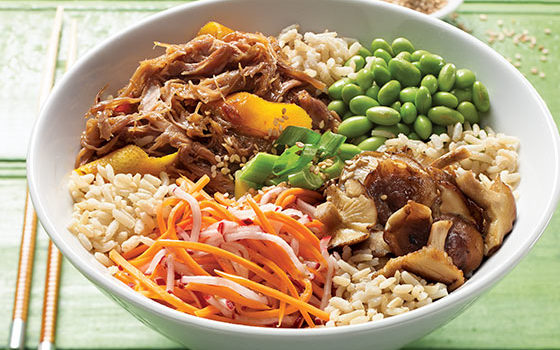Bibim-what? You may have already heard of the dish with the fun name. Bibimbap literally means “mixed rice.” Like many Korean dishes, bibimbap is a combination of various ingredients served hot or cold in a large bowl: white rice, vegetables (sautéed, raw or pickled), kimchi, and depending on the recipe, beef, pork, seafood, fish or tofu. While many restaurants now serve a fried egg as a topping, traditional bibimbap is topped with a raw egg that is cooked through the heat of the dish. Just before serving, add the sauce (chili flakes, soy sauce and sesame oil) and then mix everything together. Full of flavour and texture, bibimbap is becoming increasingly popular on this side of the world. Not only is bibimbap quick to make, but it also inspires all sorts of colourful variants. Here are some creative, delicious toppings you can add to the essentials: rice in the bottom of the bowl, an egg on top and a tangy chili sauce.
Greens
Garnish with thin strips of cucumber, steamed Chinese broccoli, avocado slices, broccoli sprouts, chopped green onions and a big handful of edamame.
Rainbow
Garnish with minced red cabbage, steamed asparagus tips, sliced radishes, thin carrot strips and grilled tofu cubes.
Forest
Garnish with stir-fried portobello mushrooms, enoki mushrooms, steamed spinach and grilled beef strips.
Asian
Garnish with minced napa cabbage, bean sprouts, steamed bok choy, wakame, kimchi and cooked ground pork.
Sunshine
Garnish with mango, zucchini and red pepper, all sliced into thin strips. Add avocado cubes and chickpeas. Now it’s your turn—what’s your favourite topping combo? Rachelle Béry Nutritionist Team

